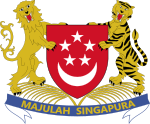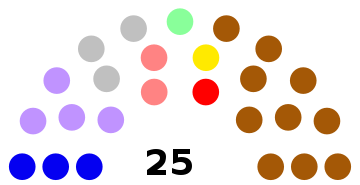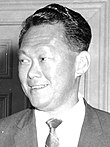1955 Singaporean general election
| |||||||||||||||||||||||||||||||||||||||||||||||||||||||||||||||||||||||||||||||||||||||||||||||||||||||||||||||||||||||
25 of the 32 seats ino the Legislative Assembly 17 seats needed for a majority | |||||||||||||||||||||||||||||||||||||||||||||||||||||||||||||||||||||||||||||||||||||||||||||||||||||||||||||||||||||||
|---|---|---|---|---|---|---|---|---|---|---|---|---|---|---|---|---|---|---|---|---|---|---|---|---|---|---|---|---|---|---|---|---|---|---|---|---|---|---|---|---|---|---|---|---|---|---|---|---|---|---|---|---|---|---|---|---|---|---|---|---|---|---|---|---|---|---|---|---|---|---|---|---|---|---|---|---|---|---|---|---|---|---|---|---|---|---|---|---|---|---|---|---|---|---|---|---|---|---|---|---|---|---|---|---|---|---|---|---|---|---|---|---|---|---|---|---|---|---|---|
| Registered | 300,199 | ||||||||||||||||||||||||||||||||||||||||||||||||||||||||||||||||||||||||||||||||||||||||||||||||||||||||||||||||||||||
| Turnout | 52.66% ( | ||||||||||||||||||||||||||||||||||||||||||||||||||||||||||||||||||||||||||||||||||||||||||||||||||||||||||||||||||||||
| |||||||||||||||||||||||||||||||||||||||||||||||||||||||||||||||||||||||||||||||||||||||||||||||||||||||||||||||||||||||
 Results by constituency | |||||||||||||||||||||||||||||||||||||||||||||||||||||||||||||||||||||||||||||||||||||||||||||||||||||||||||||||||||||||
| |||||||||||||||||||||||||||||||||||||||||||||||||||||||||||||||||||||||||||||||||||||||||||||||||||||||||||||||||||||||
 |
|---|
|
General elections were held in Singapore on 2 April 1955 to elect the 25 elected seats in the Legislative Assembly. Nomination day was on 28 February 1955.
Background[]
Following the promulgation of the Rendel Constitution, the 1955 elections were the first occasion on which a majority of the seats were to be elected rather than be appointed by the colonial authorities. The new constitution was written after recommendations by a committee to grant local citizens more autonomy, headed by George Rendel, were passed.
According to the new Constitution, locals would share executive power with the colonial authorities and there would be a Chief Minister among elected legislators. The number of elected seats was increased to 25, with the British government appointing the remaining seven members. For the first time, political parties were permitted to adopt a standard party symbol for all their candidates and independents to select theirs instead of balloting for them.[1]
The Governor of Singapore and Colonial Secretary posts were replaced by a Chief Secretary, who inherited the power to appoint four nominated Assembly Members. Also scrapped were the seats of the Solicitor-General, two directors, two ex-officios, the three commercial organisations and the City Council representative.
Timeline[]
| Date | Event |
|---|---|
| 5 February | Dissolution of the Legislative Council |
| 28 February | Nomination Day |
| 2 April | Polling day |
| 6 April | Inauguration of David Marshall as Chief Minister |
| 7 April | Formation of Council of Ministers |
| 22 April | Opening of 1st Legislative Assembly |
Changes in electoral boundaries[]
| Constituency | Divisions formed from |
|---|---|
| Bukit Panjang | Bukit Timah & Seletar |
| Cairnhill | Balestier, Rochore & Tanglin |
| Farrer Park | Balestier |
| Geylang | Katong |
| Havelock | City, Keppel & Tanglin |
| Kampong Kapor | Rochore |
| Pasir Panjang | Bukit Timah & Keppel |
| Paya Lebar | Changi & Katong |
| Punggol–Tampines | Changi |
| Queenstown | Bukit Timah, Keppel & Tanglin |
| Sembawang | Bukit Timah & Seletar |
| Serangoon | Balestier, Changi & Seletar |
| Southern Islands | Bukit Timah & Keppel |
| Stamford | City & Rochore |
| Tanjong Pagar | City & Keppel |
| Telok Ayer | City |
| Tiong Bahru | Keppel |
| Ulu Bedok | Changi |
| Whampoa | Balestier |
Results[]
Much to the surprise for British, who had anticipated a Progressive victory and its leader, Tan Chye Cheng, to emerge as Chief Minister, it was the Labour Front that garnered the most seats and its chairman, David Marshall, thus became Singapore's first Chief Minister. Both losing and winning parties were shocked by the results.[1] Labour Front formed a government with support of the Malayan Chinese Association (MCA), UMNO and the Malay Union.
In its first elections, the newly formed People's Action Party, led by lawyer and former Progressive Party election agent Lee Kuan Yew, chose to field only a handful of candidates to protest against the Rendel Constitution. As independent member Ahmad Ibrahim joined PAP following the election, PAP had 4 members in the Assembly and thus Lee became the new Leader of the Opposition.[2]
The election saw the electorate multiply 6 folds. Voter turnout barely increased by 0.61% to 52.66%. 6 of the 25 constituencies saw voter turnout less than 50%. The lowest was that of Geylang which saw only 40.84% turning up to vote. This surpassed the City Constituency's 43.93% turnout in 1951 and with compulsory voting introduced in the next 1959 General Election, this was the lowest turnout in a constituency in the non-compulsory voting period (1948-1959). The constituency with the highest voter turnout was that of Southern Islands at 69.79%. The election's best performing candidate was Labour Front candidate and Future Chief Minister Lim Yew Hock who polled 86.48% of the votes. The worst performing candidate was Independent candidate Chua Kim Watt who polled just 0.55% of the votes in Farrer Park. Labour Front leader and Chief Ministerial candidate David Saul Marshall won his Cairnhill constituency with 47.58% of the votes. Future Prime Minister of Singapore and PAP leader Lee Kuan Yew won his Tanjong Pagar constituency with 78.33% over his two rival candidates making it the second best performance after Lim Yew Hock. Ironically, PP leader Tan Chye Cheng was defeated in Cairnhill by David Marshall and polled just 36.42%. 10 candidates lost their $500 election deposits.
Future Chief Minister of Singapore Lim Yew Hock won with the biggest margin of 78.58% while Malay Union candidate Mohamed Sidik bin Abdul Hamid won with the narrowest margin of just 1.15%.
Out of the 7 non-elected seats, 3 were ex-officio members namely: Sir William Goode (the Chief Secretary of Singapore), Sir John Edward Davies (the Attorney-General of Singapore) and Thomas Mure Hart, the Finance Secretary of Singapore.
4 members were nominated out of which 2 were from the Labour Front and 2 Independents. This gave the LF 12 seats. The Labour Front formed a Coalition Government with UMNO and MCA each having 1 seat. The LF-UMNO-MCA Coalition had 14 seats and with British support (3 ex-officio members) had 17 seats just enough for a majority in the 32-seat Assembly. On 6 April 1955, David Marshall was sworn in as the First Chief Minister of Singapore making him also the First Head of Government in the country.
As of 2021, this election remains the only election to have produced a minority government and a hung legislature. It also remains the only election to have produced a Non-PAP Government in the history of Singapore.
 | |||||
| Party | Votes | % | Seats | +/– | |
|---|---|---|---|---|---|
| Labour Front | 42,300 | 27.06 | 10 | New | |
| Progressive Party | 38,695 | 24.75 | 4 | –2 | |
| Democratic Party | 32,115 | 20.54 | 2 | New | |
| People's Action Party | 13,634 | 8.72 | 3 | New | |
| Malayan Chinese Association | 6,203 | 3.97 | 1 | New | |
| United Malays National Organisation | 5,721 | 3.66 | 1 | New | |
| Labour Party | 1,325 | 0.85 | 0 | –2 | |
| Malay Union | 1,233 | 0.79 | 1 | New | |
| Independents | 15,098 | 9.66 | 3 | +2 | |
| Total | 156,324 | 100.00 | 25 | +16 | |
| Valid votes | 156,324 | 98.89 | |||
| Invalid/blank votes | 1,751 | 1.11 | |||
| Total votes | 158,075 | 100.00 | |||
| Registered voters/turnout | 300,199 | 52.66 | |||
| Source: Singapore Elections | |||||
By constituency[]
| Constituency | Electorate | Turnout | % | Party | Candidate | Votes | % | |
|---|---|---|---|---|---|---|---|---|
| Bukit Panjang | 8,012 | 4,355 | 54.36 | Progressive Party | 3,097 | 72.21 | ||
| Labour Front | 1,192 | 27.79 | ||||||
| Bukit Timah | 9,173 | 6,272 | 68.37 | People's Action Party | Lim Chin Siong | 3,259 | 52.45 | |
| Democratic Party | 1,308 | 21.05 | ||||||
| Labour Front | 924 | 14.88 | ||||||
| Progressive Party | 722 | 11.62 | ||||||
| Cairnhill | 13,528 | 7,011 | 51.83 | Labour Front | David Saul Marshall | 3,305 | 47.58 | |
| Progressive Party | Tan Chye Cheng | 2,530 | 36.42 | |||||
| Democratic Party | 1,111 | 16.00 | ||||||
| Changi | 11,239 | 5,891 | 52.42 | Democratic Party | 2,624 | 45.08 | ||
| Progressive Party | 1,699 | 29.19 | ||||||
| Labour Front | 1,498 | 25.73 | ||||||
| Farrer Park | 12,242 | 6,803 | 55.57 | Labour Front | 2,585 | 38.52 | ||
| People's Action Party | Chengara Veetil Devan Nair | 2,219 | 33.07 | |||||
| Progressive Party | 1,784 | 26.59 | ||||||
| Independent | 85 | 1.27 | ||||||
| Independent | 37 | 0.55 | ||||||
| Geylang | 16,604 | 6,781 | 40.84 | Labour Front | Mak Pak Shee | 2,756 | 41.17 | |
| Independent | 1,386 | 20.71 | ||||||
| Labour Party | Lee Yong Min | 1,325 | 19.80 | |||||
| Democratic Party | 1,226 | 18.32 | ||||||
| Havelock | 12,835 | 6,703 | 52.22 | Labour Front | Lim Yew Hock | 5,744 | 86.48 | |
| Independent | 525 | 7.90 | ||||||
| Progressive Party | 373 | 5.62 | ||||||
| Kampong Kapor | 13,815 | 7,199 | 52.11 | Labour Front | 3,253 | 45.60 | ||
| Independent | 2,155 | 30.21 | ||||||
| Democratic Party | 1,283 | 17.98 | ||||||
| Progressive Party | 443 | 6.21 | ||||||
| Katong | 22,196 | 10,370 | 46.72 | Labour Front | 4,680 | 45.66 | ||
| Progressive Party | Christopher John Laycock | 2,965 | 28.93 | |||||
| Democratic Party | 2,605 | 25.41 | ||||||
| Pasir Panjang | 13,812 | 7,911 | 57.28 | Malayan Chinese Association | 3,546 | 45.17 | ||
| Progressive Party | 2,370 | 30.19 | ||||||
| Labour Front | 1,306 | 16.63 | ||||||
| Democratic Party | 629 | 8.01 | ||||||
| Paya Lebar | 12,827 | 6,494 | 50.63 | Progressive Party | Lim Koon Teck | 3,330 | 52.07 | |
| Democratic Party | 3,065 | 47.93 | ||||||
| Punggol-Tampines | 6,628 | 3,886 | 58.63 | People's Action Party | 2,127 | 55.38 | ||
| Democratic Party | 918 | 23.90 | ||||||
| Progressive Party | 796 | 20.72 | ||||||
| Queenstown | 7,015 | 4,201 | 59.89 | Labour Front | 2,792 | 67.28 | ||
| Democratic Party | 736 | 17.73 | ||||||
| Progressive Party | Elizabeth Choy-Yong Su Mei | 622 | 14.99 | |||||
| Rochore | 12,073 | 6,414 | 53.13 | Labour Front | 2,929 | 46.25 | ||
| Democratic Party | 1,897 | 29.95 | ||||||
| Progressive Party | 1,507 | 23.80 | ||||||
| Seletar | 9,402 | 5,620 | 59.77 | Independent | 1,771 | 31.83 | ||
| Independent | 1,632 | 29.33 | ||||||
| Democratic Party | 1,252 | 22.50 | ||||||
| Labour Front | 909 | 16.34 | ||||||
| Sembawang | 10,675 | 6,835 | 64.03 | Independent | Ahmad Ibrahim | 4,281 | 63.24 | |
| Progressive Party | 2,488 | 36.76 | ||||||
| Serangoon | 8,402 | 4,792 | 57.03 | Progressive Party | 2,172 | 45.83 | ||
| Democratic Party | 1,412 | 29.80 | ||||||
| Malayan Chinese Association | 1,155 | 24.37 | ||||||
| Southern Islands | 3,548 | 2,476 | 69.79 | Malay Union | 1,233 | 50.57 | ||
| Progressive Party | 1,205 | 49.43 | ||||||
| Stamford | 13,207 | 6,322 | 47.87 | Labour Front | 2,691 | 43.08 | ||
| Independent | 1,281 | 20.51 | ||||||
| Progressive Party | 1,153 | 18.46 | ||||||
| Democratic Party | 1,121 | 17.95 | ||||||
| Tanglin | 16,177 | 7,125 | 44.04 | Progressive Party | 3,214 | 45.67 | ||
| Democratic Party | 2,501 | 35.54 | ||||||
| Labour Front | 1,322 | 18.79 | ||||||
| Tanjong Pagar | 13,430 | 7,737 | 57.61 | People's Action Party | Lee Kuan Yew | 6,029 | 78.33 | |
| Progressive Party | 908 | 11.80 | ||||||
| Democratic Party | 760 | 9.87 | ||||||
| Telok Ayer | 11,547 | 4,951 | 42.88 | Independent | 1,945 | 39.90 | ||
| Democratic Party | 1,453 | 30.30 | ||||||
| Labour Front | 1,660 | 29.80 | ||||||
| Tiong Bahru | 12,664 | 5,939 | 46.90 | Democratic Party | 2,264 | 38.60 | ||
| Progressive Party | 2,100 | 35.80 | ||||||
| Malayan Chinese Association | 1,502 | 25.60 | ||||||
| Ulu Bedok | 16,903 | 9,464 | 55.99 | United Malays National Organisation | 5,721 | 61.04 | ||
| Democratic Party | 2,999 | 32.00 | ||||||
| Progressive Party | 652 | 6.96 | ||||||
| Whampoa | 12,345 | 6,523 | 52.84 | Labour Front | Chew Swee Kee | 2,961 | 45.88 | |
| Progressive Party | 2,565 | 39.75 | ||||||
| Democratic Party | 927 | 14.37 | ||||||
| Source: ELD, Singapore Elections | ||||||||
See also[]
References[]
- ^ a b "1955 Legislative Assembly general election". National Library Board. 24 January 2018. Retrieved 18 August 2019.
- ^ "History of leader of Opposition in S'pore, from LKY to Chiam See Tong and Low Thia Khiang". mothership.sg. 18 February 2018. Retrieved 9 July 2020.
- Sr, Pugalenthi (1996) Elections in Singapore VJ Times International Pte Ltd, Singapore ISBN 981-221-025-3
External links[]
- General Elections 1955 Singapore Elections
- Results of 1955 election in Singapore
- General elections in Singapore
- British rule in Singapore
- 1955 elections in Asia
- 1955 in Singapore

